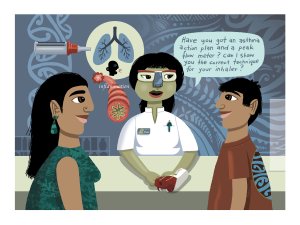Academic pharmacist Nataly Martini discusses the medical management of asthma in adults and adolescents, which has evolved to prioritise early anti-inflammatory treatment. She also explains how to improve patient outcomes by proactively identifying poor asthma control and supporting equitable access to education and treatment
An overview of common anorectal conditions
Wednesday 1 February 2023, 12:15 AM

[Image: iStock.com – AtlasStudio]
Benign anorectal conditions are very common, and patients may go to pharmacies looking for over-the-counter therapies. Pharmacists will find this article, written by colorectal and general surgeon Sze-Lin Peng, useful for prescribing initial topical treatments and advising patients to get a medical assessment
There is a wide variety of anorectal symptoms and complaints. Benign and malignant conditions may present with similar symptoms, and can also coexist,
Kia ora and welcome to Pharmacy Today Kaitiaki Rongoā O Te Wā
Not a subscriber? Unlock this article by subscribing here.
References
- Olde Bekkink M, McCowan C, Falk GA, et al. Diagnostic accuracy systematic review of rectal bleeding in combination with other symptoms, signs and tests in relation to colorectal cancer. Br J Cancer 2010;102(1):48–58.
- Araghi M, Soerjomataram I, Bardot A, et al. Changes in colorectal cancer incidence in seven high-income countries: a population-based study. Lancet Gastroenterol Hepatol 2019;4(7):511–18.
- Riss S, Weiser FA, Schwameis K, et al. The prevalence of hemorrhoids in adults. Int J Colorectal Dis 2012;27(2):215–20.
- Song M, Emilsson L, Bozorg SR, et al. Risk of colorectal cancer incidence and mortality after polypectomy: a Swedish record-linkage study. Lancet Gastroenterol Hepatol 2020; 16 March online.
- Giacosa A, Frascio F, Munizzi F. Epidemiology of colorectal polyps. Tech Coloproctol 2004;8, Supp.2:243–47.
- Gardner IH, Siddharthan RV, Tsikitis VL. Benign anorectal disease: hemorrhoids, fissures, and fistulas. Ann Gastroenterol 2020;33(1):9–18.
- Coughlin OP, Wright ME, Thorson AG, et al. Hemorrhoid banding: A cost-effectiveness analysis. Dis Colon Rectum 2019;62(9):1085–94.
- Nelson RS, Thorson AG. Risk of bleeding following hemorrhoidal banding in patients on antithrombotic therapy. Gastroenterol Clin Biol 2009;33(6–7):463–65.
- Xia W, Manning JPR, Barazanchi AWH, et al. Metronidazole following excisional haemorrhoidectomy: a systematic review and meta-analysis. ANZ J Surg 2018;88(5):408–14.
- Altomare DF, Binda GA, Canuti S, et al. The management of patients with primary chronic anal fissure: a position paper. Tech Coloproctol 2011;15(2):135–41.
- Nelson RL, Thomas K, Morgan J, et al. Non surgical therapy for anal fissure. Cochrane Database Syst Rev 2012;(2):CD003431.
- National Library of Medicine (US). Drugs and Lactation Database. Nifedipine.
- Sahebally SM, Walsh SR, Mahmood W, et al. Anal advancement flap versus lateral internal sphincterotomy for chronic anal fissure- a systematic review and meta-analysis. Int J Surg 2018;49:16–21.
- Muhlmann MD, Hayes JL, Merrie AE, et al. Complex anal fistulas: plug or flap?. ANZ J Surg 2011;81(10):720–24.
- Mitalas LE, Gosselink MP, Zimmerman DD, et al. Repeat transanal advancement flap repair: impact on the overall healing rate of high transsphincteric fistulas and on fecal continence. Dis Colon Rectum 2007;50(10):1508–11.





